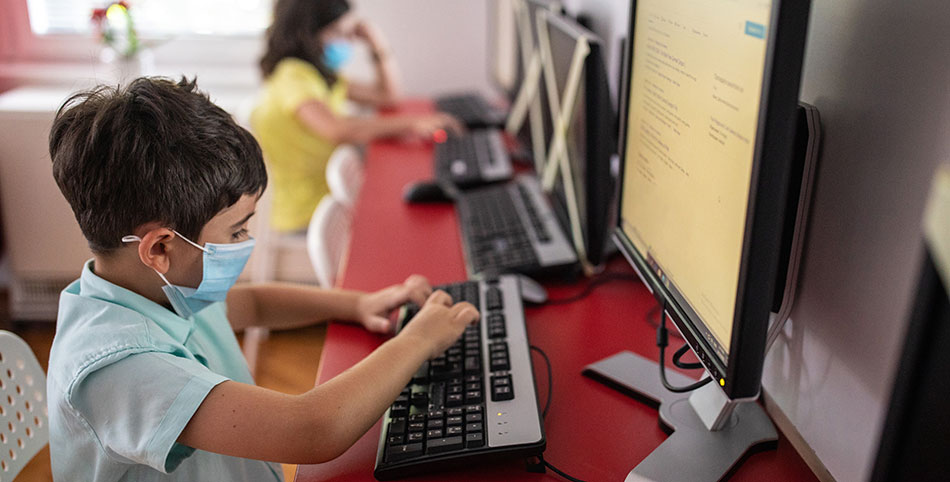Promoting Digital Equity and Opportunity in the Time of COVID-19

As part of my technical assistance work at AIR, I spent this summer meeting with a team of 10 principals in Austin, Texas. This group has worked to leverage their collective impact initiative, called NACER, as they responded to the coronavirus pandemic and the moral imperatives that have surfaced through the Black Lives Matter movement. Being a principal is complex work under normal circumstances. These days, the magnitude of the job is hard to wrap your head around.
Our weekly virtual meetings have been wide-ranging. Beyond core academics and student services, we regularly grappled with issues surrounding food distribution, utility assistance, health screenings, contact tracing, housing vulnerability, transportation, coronavirus-induced student migration and teacher shortages, and shepherding anti-racist professional development—just to name a few. The principals’ stories offer a glimpse into how multiple systems overlap inequitably across communities. After each meeting, I was reminded of the decades of educational research showing how student learning is nested within and shaped by place-specific “geographies of educational opportunity” that advantage some and disadvantage others.
Equity Takeaways From Austin
COVID-19 and the abrupt shift to virtual learning and service provisions have fundamentally altered geographies of educational opportunity. While this transition has potentially opened a space for expansive thinking and bold innovation in education, it has also amplified the need for swift and effective approaches to ensure digital equity. As a former principal, I know firsthand that these efforts frequently focus narrowly on the supply side of technology access: ensuring that every student has a device. However, like all of the issues we’ve tackled in our weekly principal meetings, digital equity is complex and entangled with other systems and must be addressed in context.
An example of this complexity surfaced as I worked to complete a dissertation as part of my Ph.D. program. In February 2020, I concluded a case study that examined how information and communications technology intersects with educational opportunity among public housing residents. The case study involved interviews with 17 residents from a single public housing property near downtown Austin and was conducted in partnership with two public housing residents and a staff member from the Housing Authority of the City of Austin (HACA).
While the case study findings are specific to a particular locale and population, the insights are timely and offer food for thought for educational leaders, particularly those who are committed to fostering equitable geographies of educational opportunity in the COVID-19 era. Here are four relevant findings with considerations for education leaders.
Finding One: Digital Equity Has a Shelf Life.
Without exception, every participant in the case study had a cell phone and a computer. However, numerous residents reported that their devices were slow, dated, and unable to execute even the most basic tasks like texting or browsing the internet. Several young adults reported that their newer school-issued laptops lacked the memory and bandwidth to handle their computer science and digital media coursework—two valuable bodies of knowledge in the future workforce.
Takeaway for education leaders: As school systems mobilize to distribute devices in the wake of COVID-19, it is critical to consider the sophistication of tasks that the technology can handle and how frequently the technology will need to be refreshed in order to sustain equitable access.
Finding Two: Broadband Access is Variable.
Focusing on communities with little or no broadband access as a way to improve digital accessibility is a sound strategy. However, even in the most wired geographies, Wi-Fi access is porous. In our study, housing residents living in the heart of tech-rich Austin struggled to maintain connectivity. Their access was often sporadic and dependent on temporary carrier sales promotions; what was affordable one week was often out-of-reach the next. In other instances, residents said that they gave up Wi-Fi first when medical bills or other unexpected costs drained their limited budgets. At the tail end of the study, a number of the study participants began receiving free broadband via an innovative partnership between HACA and Google Fiber; which one resident described as “life changing.”
Takeaway for education leaders: Sustaining community-based, public-private partnerships can be an essential component of plans to ensure digital equity for all.
Finding Three: One Size Does Not Fit All in Digital Literacy Instruction.
Many of the adult participants in the study were hungry to develop their digital proficiency (e.g., learning Excel or navigating the web). Some of the adults recognized that doing so would improve their job prospects. Others wanted to be able to support their children’s learning and monitor their online activities. While study participants universally reported that free technology classes were available nearby, most of the classes were only offered in English and often assumed a basic level of proficiency in order to participate. Several residents quit their classes because they couldn’t keep pace with the coursework and the instructors were unwilling or unable to catch them up.
Takeaway for education leaders: As school systems embark on this unique school year, education leaders should consider giving adult learning the same personalization, differentiation, and accommodations that students receive—particularly if we expect adult family members and caregivers to truly be partners in virtual education.
Finding Four: Local Wisdom and Leadership are Key.
In the urgent race to mobilize digital learning resources, it is understandable to feel that there is neither time nor bandwidth to engage community members as partners in technology deployment. However, failure to do so increases the likelihood that resources and supports will be out-of-sync with community dynamics. In our study, Mary Apostolo, HACA Board of Commissioners Resident Ambassador; Brianna Sterling, HACA resident and Smart City Ambassador; and Daniel Ruiz, HACA staff member, regularly challenged my biases and ultimately improved the research process. Our partnership was not accidental, but rather a concrete extension of an institutionalized ambassadorship program managed by HACA called Smart Work Learn Play. In this program, residents are paid to serve as co-researchers, mentors, and informed leaders on issues ranging from urban accessibility to digital literacy. COVID-19 has elevated the importance of such grounded wisdom.
Takeaway for education leaders: This school year provides an opportunity for education leaders to formalize and empower their community partners to both help strategically mobilize their technology strategies and build capacity to address what’s still to come.
Challenging times such as these create space for innovations that can expand access and opportunity. At the same time, there is concern that COVID-19 will further entrench inequalities that have plagued our country for generations. The last few months have clearly shown that technology will play a pivotal role in determining which path we take. The case study taught me that leveraging technology in the service of good requires a deeper understanding of how digital equity looks in different contexts. Fortunately for educational leaders, there are untapped community resources that can show us the way.
This In the Field piece is part of a content series developed for the Innovation Hub at AIR. The Innovation Hub is a central platform that connects AIR experts, communities of practice (CoPs), and resources to support educators and members of the general public as they navigate instructional challenges related to the COVID-19 global pandemic.
